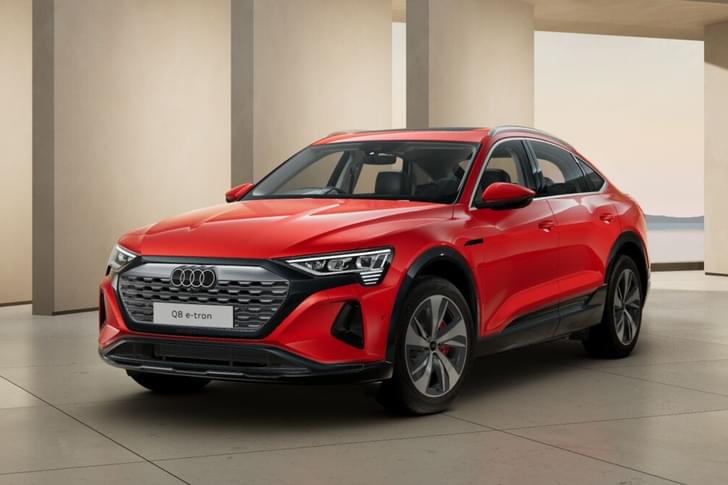‘Efficient’ and ‘environment-friendly’ aren’t words that come to mind when you think UAE, but it’s all you can think of when you’re at Masdar City in Abu Dhabi. Built to be a showcase of eco-friendly, sustainable living, Masdar boasts of using energy drawn solely from solar and renewable sources. And waiting for us here, fully charged using eco-friendly energy, was a fleet of Audi e-trons.
The e-tron moniker has been used on a few Audi concepts and production hybrids, but it’s now the name of the German brand’s all-electric SUV. Audi believes that for an electric car to be successful, it has to deliver an adequate range, decent performance and all the comforts available today. And to that end, the e-tron has a 36-cell, 95kWh battery pack providing a driving range of 400km, as tested in the Worldwide Harmonised Light Vehicle Test Procedure or WLTP cycle. As for performance, two motors delivering a combined output of 408hp propel the SUV to 100kph from 0 in 5.7sec, while top speed in limited to 200kph. And coming to creature comforts, the e-tron has everything you’d expect from a car in this class.
The VW Group does have a purpose-built, all-electric platform that underpins the Porsche Taycan and the recently unveiled e-tron GT, but for the e-tron SUV, it has gone with a highly modified Q5 platform. Just 10kg shy of 2.5 tonnes, the e-tron is a heavy car; it is longer and wider than a Q5, but the real reason for its weight is the lithium-ion battery pack that tips the scales at 700kg.
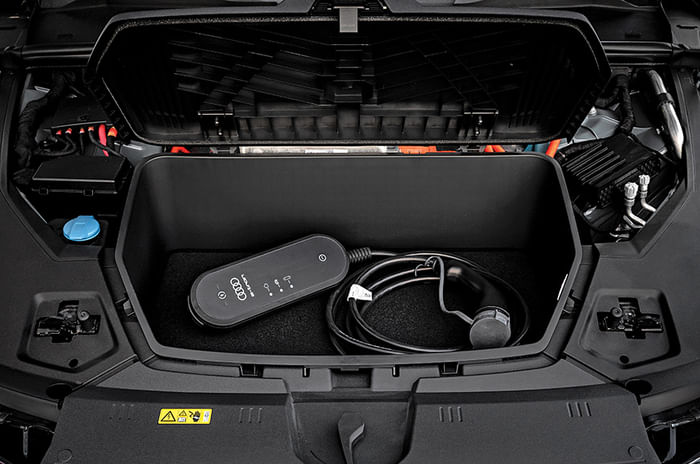
COMMON GROUND
With the Q5 at its base, much of the components, styling and proportions are similar, and that’s a good thing. Most EVs look radical – some just for the sake of doing so – but the e-tron is pretty conventional. The only futuristic bits are the camera pods in place of outside rear-view mirrors, the alloys and the front grille with its fully closing louvres, and, if you look closely, a lack of tailpipes.
The headlights are Audi’s Matrix LED units and, specific to the e-tron, are four horizontal light segments sitting at the lower-outer edge of each lamp unit. Although small in size, the camera stalks mounted on the sides are eye-catching thanks to the chrome finish on the outer edges. To further beef up the SUV look, the sides have chunky lower sills that are wider on the rear doors. The door inserts above the cladding are meant to signify the location of the e-tron’s battery pack.
The highlight of the rear is the way the lights are set up – the tail-lights stretch across the width of the car and have attractive-looking, horizontally stacked light segments at the outer ends. The bumper’s lower edge looks clean thanks to the car getting horizontal slats instead of tailpipes.
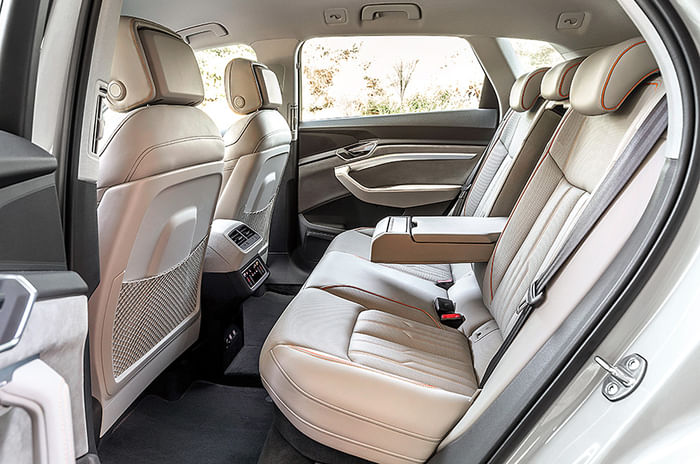
Space is more than adequate and the seats are comfy too.
TECH FEST
Except for the rear-view screens (more on this later), the interior isn’t needlessly radical and it’s all typically Audi. The dashboard layout has the now-familiar twin- touchscreen setup at the centre with the Audi Virtual Cockpit display behind the steering wheel. I’m no fan of the all-touch approach because it requires you to take your eyes off the road to look at what you’re pressing; there are better systems out there with a good mix of touch surfaces and buttons and dials.
Interior ambient lighting is used to good effect with the doors, dash, footwell and even the ‘e-tron lettering’ on the dash backlit. However, there’s a multitude of colour options and customisations on offer that can make the cabin look gaudy; I found the softer shades to be the best looking.
Being longer and wider than a Q5, the e-tron comes with more space. Passengers – at the front and rear – will have nothing to complain about, and this includes the passenger in the middle who doesn’t have a massive centre tunnel to contend with; thank you, flat battery pack. The seats are very comfy too and the seven-odd hours I spent with the e-tron didn’t leave me with any ache or pain.
.jpg?w=700&c=0)
One bit that was a pain, though, was the optional rear-view camera system (you can fit regular mirrors). High-contrast OLED screens mounted inside are fed live videos from the heated cameras outside. Compared to the traditional mirrors, these project less, and the shape and smaller cross-section reduces wind noise, while aero drag drops from 0.28 to 0.27. The cameras switch between three views automatically – highway (narrow), turning (wide angle for a reduced blind spot) and parking (dipped to spot a curb) – and Audi claims the screens provide a better image than mirrors, even in bright sunlight. Trouble is, there are a few issues. For one, the screens are mounted low and require you to look lower than you normally would. Also, the cameras are not mounted flush with the body; a minimum projection is needed for the 360-degree camera. So, as a result, your eyes are drawn to the projecting stalks. Even if you get used to this – I didn’t – there are other problems. Your eyes take time to adjust to the screen when you’re driving in bright sunlight with sunglasses on; potentially unsafe, as it robs you of a fraction of a second. You also can’t simply lean forward to change your angle of view as you’d normally do if you were looking to rejoin traffic; here, you’ll have to touch the screen and manually change the angle. The lack of mirrors can also be a negative for other road users because, if you are planning to overtake, you can’t actually see if an e-tron driver is paying attention. But like any new tech the system probably needs some ironing out.
BRIGHT SPARK
The rest of the drive experience, however, is simply outstanding. Let’s begin with power. Although you won’t find any ‘Quattro’ badging, it is a four-wheel-drive system thanks to a motor on each axle. The one powering the front produces 184hp, while the rear makes 224hp. Combined, they give the e-tron a max output of 408hp, but this is only in Boost mode; in the normal drive mode, it stands at 360hp (170hp front +190hp rear). In either mode, however, thanks to the ability of electric motors to deliver all their torque immediately, power delivery is instant. Simply tap the throttle and there is an instant surge of power and it just keeps going in a very linear manner; the linearity may not be exciting but it’s quick and does the job well.
Another thing the motors do well is braking. Yes, the e-tron motors provide a decent amount of ‘engine braking’ and Audi states that 90 percent of the time it will be the motors alone that will provide deceleration. Even if you do use the brake pedal, the wheel brakes are only called to duty during rapid deceleration (above 0.3 g-force). The amount of motor braking can be set via the steering wheel paddles, with three levels on offer – zero, mild and max effect. The idea isn’t new – some hybrids employ a mix of motor and wheel braking – but, of the cars I’ve driven so far, none have provided the smoothness in the mix like the e-tron. Hit the pedal and the retardation is uniform, and it’s hard to tell when the wheel brakes kick in, unlike other systems that tend to grab suddenly. Pedal feel is excellent, with the elastic material providing just the right amount of resistance, you’d never know you’re actually only stamping down on a big switch. The electrohydraulic brakes build pressure twice as fast as conventional hydraulic units, and this enables the brake pads to be set further away from the disc, lowering rolling friction. Also, under automated emergency braking, it takes only 150 milliseconds to go from activation to full brake pressure; this can shorten braking distance by up to 20 percent over regular hydraulic brakes.

TOUR DE FORCE
This is an SUV and an electric one at that, and while I wasn’t expecting much in terms of performance, I certainly wasn’t in the least bit expecting great handling, but the e-tron did surprise here. The battery mass is concentrated low down all along the floor, between the front and rear wheels, and Audi says the e-tron’s front-rear weight distribution is close to 50:50. Audi did chalk out a neat 10km twisty climb up the mountains and the SUV felt very neutral through the wonderfully laid-out curves. But switch off ESP and it’s possible to get the rear to step out. The all-wheel-drive system is really in its element here, and, in most cases, power is provided by the rear motor and with no mechanical components. Activating power at the front axle is simply a matter of turning on the electricity; it takes just about 30 milliseconds for the system to detect and kick in the appropriate amount of torque. Audi says the system performs better than their regular Quattro does, and after my drive I don’t doubt them. We had some light off-roading thrown in as well, and, even here, the system was simply super in getting the power down quickly and there was no fuss over rocks or through sand. As for the steering feel, on the whole, it’s light but freakishly so at parking speeds.
Air springs do duty all round and they vary rideheight and damper firmness, along with the seven driving modes available. For example, in Efficiency mode, the body is lowered to aid aerodynamics while ‘Off-road’ increases the height. Typical of air springs, there is a harder edge to the ride, but this is also likely down to the large 21-inch tyres our car was shod with.
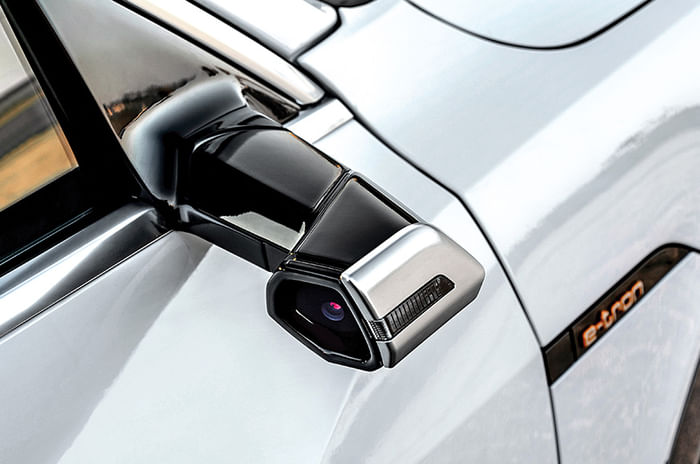
GOING PLACES
You’re probably wondering about the range by now, and so were we, all through our drive. Audi claims a 400km distance on a full charge, but that of course is under standard test conditions. With our acceleration bursts, tyre squealing runs up the mountain and stops for pictures, we would have burned through the charge in about 250km; still very respectable, and so a lunch time top-up was called for. The e-tron can fill its cells to 80 percent of their capacity within 30 minutes via a DC fast-charger or via home AC current with either a 230V or a faster 400V system. Charging infrastructure is one hurdle the e-tron will have to clear when it makes it to our shores.
So should you go all-electric? Well, it does come with its share of challenges, including that of price. Electric tech doesn’t come cheap and neither will the e-tron; we’re likely to see a price nearly double that of a Q7. Plus there’s the availability, or the lack of clean electricity, and also the matter of battery recycling which is still not ironed out. What about the product? Audi says to realise an electric future, cars will have to deliver range, comfort and performance. Range and refilling though great for an EV are a step behind conventional-fuelled vehicles, and the lack of fast-chargers in India could be a problem. However, most owners should easily see a range of over 300km, which is quite manageable to say the least. As for comfort, the e-tron’s cabin is a great place to be in – it’s well equipped and has all the safety bits you’d expect plus some more; it’s certainly not lacking in any way. And then there’s performance. Manufactures go to great lengths to quieten internal combustion (IC) engines, but, with its electric motors, the e-tron is inherently silent. Moreover, Audi has further isolated the motor whine and has done an excellent job with keeping tyre and wind noise down too.
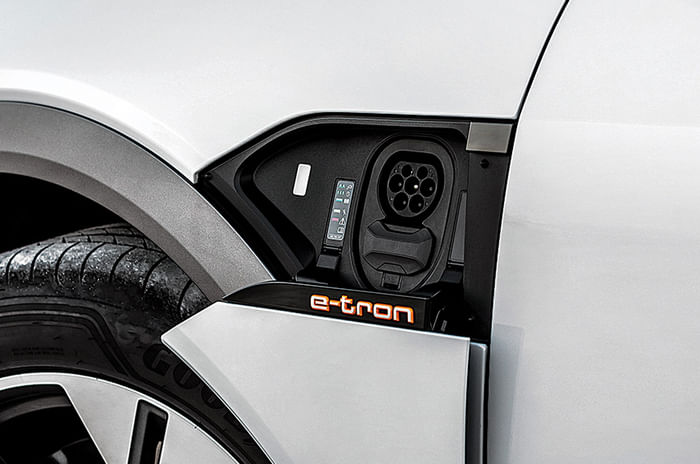
Then there’s acceleration. Again, IC engines are worked on a lot to deliver an instant response; something that’s inherent in an electric motor. Consider the e-tron’s faster acting brakes and all-wheel-drive system and Audi’s EV delivers performance rivaling or surpassing conventional IC engine vehicles. Audi says that the e-tron is the start of a new march ahead, and after a day with it, I think it’s safe to say, forget the future, the e-tron is ready for right now.





















.jpg?w=728&q=75)
.jpg?w=728&q=75)
.jpg?w=728&q=75)





